I spend a great deal of my time in schools helping teachers
to build great classroom libraries and learn to successfully match
books to children and teens. When I suggest adding comic books
and graphic novels to a classroom collection, teachers inevitably
respond, “Oh, yes, those books are so good for introducing
struggling male readers to real books.” And while I never
scream and pull my hair, this response always makes me want to
do so. Comics and graphic novels are not just for struggling readers,
not just for boys, and they are real books – books that
have too often been either marginalized or maligned by parents,
teachers, and librarians, but books that have a legitimate and
valuable place in any home or classroom library.
Visual Literacy
Most adults ignore comics as a legitimate form of literature
because they contain more pictures than words; however, this
aspect of comics can be good for readers. Readers who have the
ability to attend to and glean information from a variety of
types of illustrative materials are said to be visually literate,
and this visual literacy can enhance reading of classroom texts.
Several research studies have revealed that illustrations (photographs,
graphs, maps, drawings) account for at least 50% of all material
found in instructional textbooks. In addition, learners who
know how to “read” illustrations perform significantly
better than learners who do not know how to utilize illustrations.
Since comics and graphic novels consist of mostly illustrations,
knowing how to read those texts and the graphics that accompany
them can actually increase reading achievement.
Multiple Literacies
I was hanging out in the children’s and young adult
section of my local Barnes and Noble a few weeks ago (something
I do so often many people think I actually work there) when
I overheard a girl trying to talk her mother into buying one
of a series of graphic novels. The mother wanted her daughter
to choose something hard to read since she perceived comics
to be easy reading. I quickly jumped to the defense of the girl
and the comic itself, introducing myself to the mother as a
reading specialist and showing the mom the often-overlooked
reading skills associated with reading graphic texts. In a world
in which much of what constitutes daily reading for many people
is found on computer screens, her daughter was – through
effective comic reading – becoming a more astute consumer
of real-world literacy. Think of our computer screens and our
computer-dominated reading tasks. The screen is not a linear
exercise – it is not “read” left-to-right
top-to-bottom. Internet reading demands an attention to those
things which take visual precedence. Reading comics and graphic
novels, particularly forms such as manga, demand that the reader
understand the language of visual precedence – how to
at the very least “read” colors, directionality,
symbolism, and facial attributes in order to comprehend the
story. Any adult who thinks that comics are easy reading hasn’t
read a comic since Archie. I also pointed out that the Printz
Award for adolescent literature went to a graphic novel in 2007
which seemed to lend a great deal of credibility to my arguments.
Fortunately, her mom bought my spiel and the girl left with
an armload of the entire graphic novel series.
Comics for Girls
Comics have long been mainly a male-dominated genre –
guys wrote them, most of the lead characters where male, and
they were directed toward a mostly-male readership. However,
in recent years a growing female readership has emerged causing
publishing houses to cater to this new and vocal consumer group.
For girls looking for comics and parents and teachers interested
in matching female readers to comics and graphic novels, I offer
to you a few of my favorites:
 The
Babymouse Series by Jennifer L. and Matthew Holm
The
Babymouse Series by Jennifer L. and Matthew Holm
(All Ages)
This graphic novel series written and illustrated by a sister-brother
team includes Babymouse #1 : Queen of the World (2005),
Babymouse #2: Our Hero (2005), Babymouse #3: Beach
Babe (2006), Babymouse #4: Rockstar (2006), Babymouse
#5: Heartbreaker (2006), Babymouse #6: Camp Babymouse
(2005)7, Babymouse #7: Skater Girl (2007), and Babymouse
#8: Puppy Love (2007). The series follows the hilarious
antics of Babymouse who is a typical middle school girl mouse
navigating the typically treacherous waters of adolescence.
She is attacked constantly by her not-just-uncooperative-but-deadly
locker and thwarted by her nemesis, Felicia Furrypaws, the most
popular girl – and meanest – in the school. Babymouse
daydreams herself away from her real world and into a fantasy
one in which she is popular and talented and victorious over
Felicia Furrypaws and her minions. Each daydream sequence is
washed in pink and is, for anyone who has ever had, been, or
taught a middle school child poignantly accurate and uproarious.
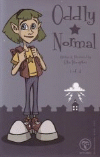 The
Oddly Normal Series by Otis Frampton
The
Oddly Normal Series by Otis Frampton
(Ages 10 and up)
This graphic novel series (volumes 1 – 4) follows the
adventures of a 10-year-old girl named Oddly Normal who is half-witch/half-human.
On her 10th birthday her parents mysteriously disappear and
Oddly is left in the care of her great aunt. Since her new guardian
is a full-witch and lives in an alternate universe known as
Fignation, that is where Oddly’s adventures and her quest
to learn about the fate of her parents take place. She enrolls
at the local school, gains new friends and enemies, and learns
that the trials of growing up “just a little different”
are much the same in any universe.
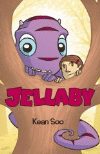 The
Jellaby Series by Kean Soo
The
Jellaby Series by Kean Soo
(Ages 10 and up)
The first in this graphic novel series is slated for a February,
2008 release. I am already addicted to the adventures of ten-year-old
Portia Bennett and her purple monster, Jellaby. Portia wakes
one night and follows a noise into the woods next to her house.
In them she finds a gigantic lost purple creature who she befriends,
takes home, and names Jellaby. When Jellaby follows her to school
the next day, the two hide on the roof of the school where they
spy a boy being picked on by two other playground bullies. Portia
intercedes and she and Jellaby find a new friend, Jason. When
the three friends see a photograph of a mysterious door in the
newspaper which they believe may lead to Jellaby’s home,
they decide to take a Halloween trip to Toronto to investigate.
A secondary mystery, that of Portia’s missing and possibly
dead father forms a serious undercurrent to the light adventures
of Portia, Jason, and Jellaby.
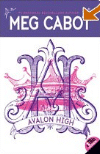 The
Avalon High Series by Meg Cabot
The
Avalon High Series by Meg Cabot
(Ages 12 and up)
Perhaps best known for The Princess Diary books,
Meg Cabot has recently begun a series of graphic novel adaptations
of her Avalon High novel (2005). Drawn in rich black and white
illustrations and in panels closely resembling Japanese manga,
this series tells the tale of an ordinary teenage girl who just
might be the incarnation of the Lady of the Lake and just might
be dating the incarnation of King Arthur. Of course the modern-day
retelling of the story (or reliving of the story) wouldn’t
be complete without Merlin, Mordred, and Lancelot. And aren’t
all popular-yet-evil high school girls just a little like Morgan
le Fay?
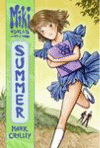 The
Miki Falls Series by Mark Crilley
The
Miki Falls Series by Mark Crilley
(Ages 13 and up)
The Miki Falls series includes four books: Miki Falls: Spring
(May, 2007), Miki Falls: Summer (June, 2007),
Miki Falls: Autumn (September, 2007), and Miki
Falls: Winter (Slated for January, 2008). This series is
an American version of Japanese Manga which looks and feels
close to the original tradition complete with Manga-styled facial
features and a story set in Japan. Miki Yoshida, the heroine
of the series, meets and is infatuated with her high school’s
new handsome student. While he at first seems to be tantalizingly
unattainable, she soon learns that his aloof manner hides a
mysterious double life. Their forbidden young love leads them
into danger and adventure as the series unfolds. The artwork
in this series is breathtakingly beautiful and the panel layouts
serve to heighten the tempo and tension of the text.
 The
Minx Imprint - DC Comics
The
Minx Imprint - DC Comics
(Ages 14 and up)
In response to a growing young female readership, D C Comics
has recently launched the Minx imprint. Titles include Re-Gifters
(2007), Clubbing (2007), Confessions of a Blabbermouth
(2007), Good as Lily (2007), The Plain Janes
(2007), and kimmee66 (2007). A sixth title, Water
Baby is slated for release in May, 2008. These titles are
not part of a series, rather they are part of an imprint directed
at a high-school-age female market. They involve high school
female lead characters and typical high school social dramas
often mixed with a bit of the supernatural. While I admit that
this series is among my most favorite and can tell you that
I waited dearly for the release of each volume, be aware that
with typical teenage drama comes typical teenage language –
the kind teens say among themselves that adults wish to believe
they never utter! This series is definitely for a high school
reader.
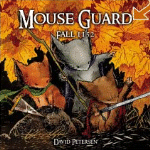 The
Mouse Guard Series by David Petersen
The
Mouse Guard Series by David Petersen
(Ages 10 and up)
This series, reminiscent of a cross between The Rats of
Nimh, and Watership Down with a little Knights
of the Round Table in the mix, includes Mouse Guard Volume
1: Fall 1152 (2007), Mouse Guard Volume 2: Winter 1152
(2007), Mouse Guard Volume 3: Rise of the Axe (2006),
Mouse Guard Volume 4: The Dark Ghost (2006), Mouse
Guard Volume 5: Midnight’s Dawn (2006), and Mouse
Guard Volume 6: A Return to Honor (2007). The series follows
a group of mouse guards including very strong female warriors
as lead characters as they journey across mouse territory and
battle enemies to uncover and thwart a plan to destroy the Mouse
Guard. The richly color-saturated illustrations convey a deeper
understanding of the story than that told by the text alone.
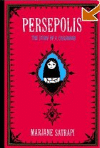 The
Persepolis Series by Marjane Satrapi
The
Persepolis Series by Marjane Satrapi
(Ages High School to Adult)
The two volumes in this series, Persepolis: The Story of
a Childhood (2004), and Persepolis 2: The Story of
a Return (2005) have most recently been released in comic
form as a major motion picture. The series tells the autobiographical
story of a young girl living in Iran during the Islamic Revolution
of 1979 which ushered in a new religious state. In 1984 her
parents sent her to safety in Europe where she tests the boundaries
of her new freedom, experiments with drugs and boys and eventually
is forced home to Tehran where her liberalism and freedom collide
with the religious police. Readers of these texts experience
war and turmoil from the inside-out. Themes of sex and drugs
make this book one for high school to adult.
Additional Recommendations
To Dance by Siena Cherson Siegel (2006) tells the
author’s autobiographical story of growing up in Puerto
Rico, moving with her family to Boston, and later being accepted
to The School of American Ballet in New York. When an ankle
injury ends her professional career, Siegel attends college
and later returns to dance. This tale does not glamorize a dancer’s
life; rather it reveals the hard work, pains, and disillusionment
of injury as well as the triumph of the human spirit. Recommended
for ages 8 and up.
Biker Girl by Misako Rocks (2006). In this manga-style
comic Aki becomes a reluctant superhero when a motorbike in
her garage comes to life. The heroine discovers that she is
descended from a long line of biker heroes like her cousin Toru
who once owned the bike and was killed by the leader of a rival
biker gang. The gang leader challenges her to a race which she
wins with the help of the magical bike. Recommended for ages
10 and up.
In addition, new graphic adaptations of The Babysitters
Club by Ann Martin and Coraline by Neil Gaiman
have recently been released which will delight new readers as
well as those familiar with the original texts.
To Learn More about the History of Comics
For adults and young readers alike, I recommend Comic Book
Century: The History of American Comic Books (2008) by
Stephen Krensky. It is a concise and truly interesting look
into the history of American comic books from the golden age
of comics through modern graphic novels.
Finally
Comics and graphic novels are not only entertaining for readers
of all ages, they can actually increase reading achievement.
So for the boys and girls in your lives (and for adults as well)…let
them read comics!











